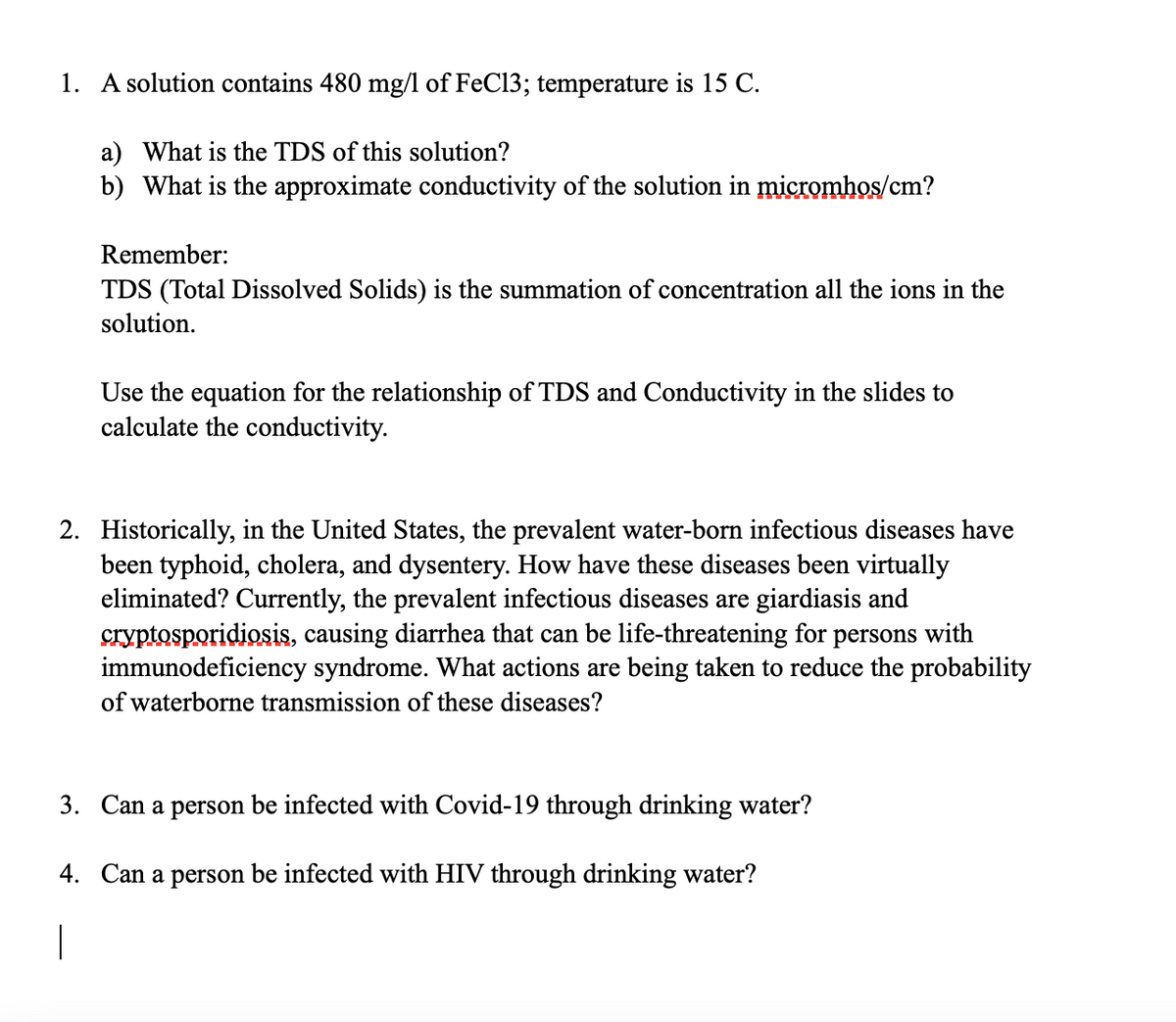1. A solution contains 480 mg/l of FeC13; temperature is 15 C. a) What is the TDS of this solution? b) What is the approximate conductivity of the solution in micromhos/cm? Remember: TDS (Total Dissolved Solids) is the summation of concentration all the ions in the solution. Use the equation for the relationship of TDS and Conductivity in the slides to calculate the conductivity.
1. A solution contains 480 mg/l of FeC13; temperature is 15 C. a) What is the TDS of this solution? b) What is the approximate conductivity of the solution in micromhos/cm? Remember: TDS (Total Dissolved Solids) is the summation of concentration all the ions in the solution. Use the equation for the relationship of TDS and Conductivity in the slides to calculate the conductivity.
Chapter11: Properties Of Solutions
Section: Chapter Questions
Problem 109AE: Patients undergoing an upper gastrointestinal tract laboratory test are typically given an X-ray...
Related questions
Question

Transcribed Image Text:1. A solution contains 480 mg/l of FeC13; temperature is 15 C.
a) What is the TDS of this solution?
b) What is the approximate conductivity of the solution in micromhos/cm?
Remember:
TDS (Total Dissolved Solids) is the summation of concentration all the ions in the
solution.
Use the equation for the relationship of TDS and Conductivity in the slides to
calculate the conductivity.
2. Historically, in the United States, the prevalent water-born infectious diseases have
been typhoid, cholera, and dysentery. How have these diseases been virtually
eliminated? Currently, the prevalent infectious diseases are giardiasis and
cryptosporidiosis, causing diarrhea that can be life-threatening for persons with
immunodeficiency syndrome. What actions are being taken to reduce the probability
of waterborne transmission of these diseases?
3. Can a person be infected with Covid-19 through drinking water?
4. Can a person be infected with HIV through drinking water?
Expert Solution
This question has been solved!
Explore an expertly crafted, step-by-step solution for a thorough understanding of key concepts.
This is a popular solution!
Trending now
This is a popular solution!
Step by step
Solved in 2 steps

Knowledge Booster
Learn more about
Need a deep-dive on the concept behind this application? Look no further. Learn more about this topic, chemistry and related others by exploring similar questions and additional content below.Recommended textbooks for you


Chemistry
Chemistry
ISBN:
9781305957404
Author:
Steven S. Zumdahl, Susan A. Zumdahl, Donald J. DeCoste
Publisher:
Cengage Learning

Chemistry: An Atoms First Approach
Chemistry
ISBN:
9781305079243
Author:
Steven S. Zumdahl, Susan A. Zumdahl
Publisher:
Cengage Learning


Chemistry
Chemistry
ISBN:
9781305957404
Author:
Steven S. Zumdahl, Susan A. Zumdahl, Donald J. DeCoste
Publisher:
Cengage Learning

Chemistry: An Atoms First Approach
Chemistry
ISBN:
9781305079243
Author:
Steven S. Zumdahl, Susan A. Zumdahl
Publisher:
Cengage Learning

Chemistry: The Molecular Science
Chemistry
ISBN:
9781285199047
Author:
John W. Moore, Conrad L. Stanitski
Publisher:
Cengage Learning